Poisonous Plants of Belize
and Central America
While many plants are highly poisonous when ingested, simply touching certain plants can also cause serious problems. There are many dangerous contact-poisonous plants throughout the world, especially in the tropics. These plants can cause severe pain, rashes, blisters or leave scars. Some trees are reported to be so powerful that even raindrops falling from them can irritate the skin. Other plant species can cause blindness through the smoke of burning wood or from rubbing the eyes after touching the leaves.
Active Principles:
Like animals and insects, plants make use of different techniques to scare away unwanted visitors. The most obvious defense mechanism a plant can use is called mechanical, for example prickles, thorns, or barbs. Less visible but also purely mechanical are the sharp edges of certain grasses which can cause unpleasant cuts
The chemical agents of some plants are poisons that can enter the skin without mechanical action. When the sap of some species gets onto the skin surface it can lead to painful skin irritation or irreversible damages. Some species can even cause temporary or permanent blindness if a person touches broken parts of the plant and then the own eyes. Throwing such plant material into a fire can also be dangerous as the smoke can irritate the skin or also lead to blindness. Most members of the Rubber Family (Euphorbiaceae) contain a milky sap which is skin-irritating and very poisonous.
A more sophisticated principle is the mechanical-chemical one: Plants penetrate the skin of the victim mechanically and introduce a poisonous chemical. The result is often immediate burning sensation of the skin. Most mechanically-chemically acting plants belong to the botanical families Urticaceae and Euphorbiaceae. Under an electron microscope, fragile hollow needles become visible with nettle cells at their bases, filled with liquid poison. When touched, the needles break off, leaving oblique tips which can enter the human skin like syringes and release the poison.
Black Poison Wood (Metopium toxiferum Krug)
Anacardiaceae family (Sumac family)
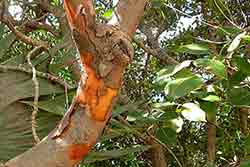
Poisonwood is an evergreen shrub or medium tree that reaches heights of 25' to 35' or taller. It characteristically has a short trunk with stout arching limbs and drooping branches that form a spreading, rounded crown. Poisonwood is often a shrub in the pine lands and a larger tree in the hammocks. The reddish-brown or gray bark is thin and has dark, oily patches from the gummy sap. Older trunks have scaly bark. The latex sometimes emerges by itself from bark and leaves and becomes black when exposed to air.
The plant blossoms are white. The fruit is a yellow-orange drupe that is about ½" long. The fruit hangs loosely in clusters and each drupe contains one, ¼", hard, brown seed.
The sap contains alkaloids that cause serious skin and mucus irritations after skin contact. Any part of the tree may carry the sap so handling any part of the Poisonwood should be avoided. The smoke of the burning wood is also skin-irritating and potentially damaging to the eyes.
The cure for the poisonwood tree is the gumbo-limbo tree which is often found growing close to the Poisonwood. Bark from the gumbo-limbo should be applied to the affected area, and the wound should be washed three times a day with water in which the bark has been boiled. Using young gumbo-limbo leaves has the same medicinal effect.
Blinding Tree (Excoecaria agallocha L)
Family: Euphorbiaceae (Rubber family)
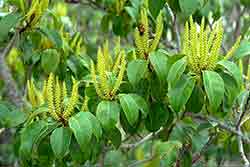
Resembling the Mangrove, the Blinding Tree grows up to 40 feet tall, with evergreen leaves 4 to 8 inches long. The tiny, fragrant blossoms are yellowish-green and the fruit resemble peas. Like most plants in the rubber family this plant contains a milky sap.
Getting the latex sap gets into the eye can result in blindness. On the skin, the sap causes severe burning, inflammation and blistering. Permanent damage is possible. All parts of this plant are also poisonous when ingested. The plant is known to be a fish poison. If exposed you should aggressively wash the skin and apply a hydrocortisone ointment. If you are unlucky enough to get the sap in your eyes, immediately wash the eyes with lots of water and seek immediate professional medical treatment.
Cashew Nut Tree (Anacardium occidentale L)
Anacardiaceae family (Sumac family)
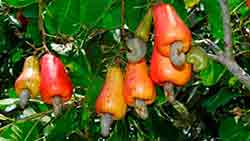
This evergreen tree grows up to 35 feet tall with leathery leaves, white blossoms with pink stripes and a fruit which consists of two parts: The upper part (the Cashew apple) is red, yellow or white and contains white edible pulp (tasting sweet and slightly peppery). The lower part of the fruit is grey and very skin-irritating. It contains the Cashew nut which is edible only after being roasted.
The sap from the bark, leaves and particularly the nutshell can cause painful skin alterations which resemble second-degree burns. The brown and oily sap becomes black when exposed to the air. Fumes from roasting the nuts are skin-irritating and can lead to blindness. Use extreme caution when harvesting nuts or fruits and also when roasting the nuts. Seek medical attention if severely exposed.
Cowhage (Mucuna pruriens; Dc)
Family: Fabaceae (Leguminosae) (Legume family)
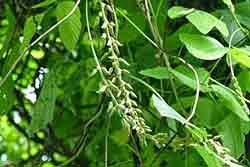
Cowhage is a creeper with whitish-greenish to purple or red inflorescences. Blossoms are sometimes hairy. Pods are covered with approx. 5000 hairs which easily break off. The hairs on fruit and blossom have barbs and contain itch-producing Mucunain.
The hairs act as a mechanical-chemical skin-irritant. If only one of the hairs gets on the skin, itch can already be felt. Reddening of the skin and small papules or urticaria occur a few minutes after contact with the hairy parts of the plant. The hairs of the Cowhage break off easily and can contaminate clothes or other objects. Dried parts of the plant remain active. There is no serious danger, except when the hairs get into the eye, in which case blindness is very possible. See a doctor immediately if hairs got into the eyes.
Dumbcane (Dieffenbachia seguina)
Family: Araceae
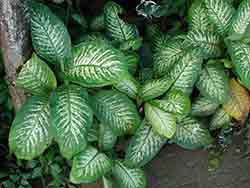
This herb is often found in river valleys and on steep slopes. It differs from its relative the philodendron, as it is strictly a terrestrial plant. Freshly cut parts are very skin irritating. After one day rashes develop. Irreversible skin damage is possible. When brought into the eye, the sap can cause injury of the cornea. All parts of this plant are very poisonous when ingested. Some investigators claim that Dieffenbachia contains an active enzyme that can cause suffocation through swelling of the throat and larynx.
Manchineel Tree (Hippomane mancinell L)
Family: Euphorbiaceae (Rubber family)

A small branching tree with light brown smooth bark and very small green blossoms. The fruit resemble small green apples. The this tree also contains a milky sap. This may be the most poisonous tree in the world. Avoid it.
The sap causes a violent burning sensation after approxomatly one half an hour If a small drop of the caustic latex or the smoke of the burning tree gets into the eyes, blindness can be the result. Even raindrops falling from a Manchineel tree can cause skin damages and severe eye irritation. All parts of the plant are also very poisonous and carcinogenic when ingested.
If exposed you should aggressively wash the skin and apply a corticosteroid ointment. If you get the sap in your eyes, Immediately wash the eyes with lots of water and seek immediate professional medical treatment.
Oleander (Nerium oleander)
Family: Apocynaceae (Dogbane Family)

This is a very popular flowering shrub in the sub-tropics and tropics. It commonly has flowers in the pink to purple range, but can also be found in white and yellow. Oleander was known to the ancient Romans. It is commonly cultivated in parks and gardens, despite the fact that all parts of it are deadly toxic. It contains two toxins that cause vomiting, dizziness, stomach cramps, convulsions, and may cause death. Chewing on any part of this plant can lead to a very bad day. Even the smoke from burning Oleander is highly toxic.
Nettle Tree (Urera baccifera)
Family: Urticaceae (Nettle family)

A small bush, shrub or tree, covered with stinging hairs. Even a slight touch will result in a burninging sensation and itching. Later reddening and often blistering will occure. Sleeplessness and fever can occur when extensive areas of the skin are affected. Leaves streaking the body can cause severe pain which can last for 24 hours or more.
Sand-Box Tree (Hura crepitans L)
Family: Euphorbiaceae (Rubber family)

This tree can grow up to 75 feet tall. The bark is covered with lots of short spines. Inconspicuous reddish-brown blossoms. The woody fruit resemble small pumpkins and explode with a loud bang when ripe making them dangerous to handle. Like many members of the Rubber family, this tree contains skin-irritating caustic latex sap.
Getting the latex into the eye can cause cornea damages or blindmess. It is slso poisonous when ingested. The parts of this plant are poisonous also for fish and insects and therefore traditionally used as fish poison.
Stinging Nettle (Urtica dioica L)
Family: Urticaceae (Nettle family)
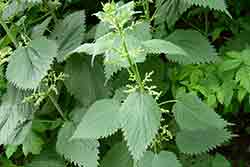
A perennial shrub up to 4 feet high with an unbranched upright stem. Blossoms are greenish and bloom from July through October in the northern temperate zone and year around in the tropics. Parts above ground are covered with stinging hairs. After slightly touching the plant, a burning sensation and itching may occur, including reddening of the skin and perhaps blistering. The young leaves are sometimes used as cooked vegetables, the poisonous effect disappears after cooking. The sap of Sorrel, often found near to Stinging Nettles, can be used to alleviate the effects of the Stinging Nettle.
Stinging Spurge (Jatropha urens L)
Family: Euphorbiaceae (Rubber family)

Stinging Spurge can be a bush, shrub, or small tree. It has white blossoms and milky latex. The whole plant is covered with long rigid stinging hairs. A slight touch can cause severe burning and pain, often with numbness of the affected skin area for a day or longer and some blistering.
